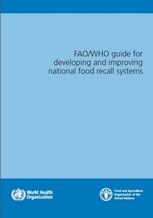Product Recall Standards for Food: GS1 and ISO 10393 Overview
Producers work diligently to bring safe food to market; however, problems may arise that can be attributed to many areas of the complex global value chain, some out of the direct control of producers. In some instances, it may be critical that a corrective action such as food recalls are carried out quickly and effectively and that all parties know their roles and execute flawlessly. This is where global food recall standards are vital to reducing risk and protecting lives.
In 2008, the US food industry, led by the Grocery Manufacturers Association (GMA) and the Food Marketing Institute (FMI), realized they needed to collaborate to improve food traceability and create product recall standards that would remove unsafe foods from the market more effectively.
At the time, one analyst suggested that it took an average of 18 days to sense and act on a food recall. It took a further 42 days to complete the food recall and only 43% of products – in the most serious food recall category – were actually traced (to the point of purchase). This needed to change.
GS1 Product Recall Standard
GS1, a global not-for-profit standards organization, was engaged to develop a global recall standard applicable for food.
The GS1 product recall standard and accompanying multi-jurisdictional implementation guide was ratified and published in June 2012. It took 4 years of standards developments efforts and inputs from over 30 countries. The GS1 product recall standard is a common-sense blueprint enabling all supply chain stakeholders to execute more effective product recall processes and notifications. The standard defines, standardizes and harmonizes the critical attributes that need to be identified, captured and shared among trading parties and regulators during the food recall alerting and messaging process.
ISO 10393 Product Recall Standard
ISO 10393, the Consumer Product Recall, Guidelines for Suppliers, was published in 2013. It is complimentary to the GS1 product recall standard and designed to provide practical guidance for suppliers to determine whether they need to carry out corrective actions.
If a food recall is necessary, the guidance provides information and tools that suppliers of all sizes can use to develop a documented and validated food recall program that will help implement timely and cost-effective recalls, minimize legal and reputation risks, and reduce health or safety risks to consumers.
Although intended for suppliers, the ISO Consumer Recall Guideline can also help government agencies develop or improve product recall policies and guidelines. While many countries have regulations in place and guidance for suppliers to conduct a food recall, many do not. In countries with well-developed regulations, a food recall may still be ineffective. Inconsistencies in corrective actions may pose health and safety risks to consumers. A product recall standard for food is the best protection.
In the case of recalls and withdrawals, the GS1 product recall standard becomes the “how-to” guide and facilitates structured processes and automated notification systems as a mechanism for implementing these ISO guidelines.
Comparison of GS1 and ISO Product Recall Standards for Food: Source: GS1
Additional information on Food Recalls:
- Food Recalls Overview
- Overview of Major Food Recall Portals in the Public and Private Sectors
- FAO/WHO Guide for Developing and Improving National Food Recall Systems
To have more articles like this emailed to your inbox, become a GFSR Member today!

-
 FeaturedRisk management
The Cost of a Breach: What a Cyberattack Could Mean for Food Safety Recalls
FeaturedRisk management
The Cost of a Breach: What a Cyberattack Could Mean for Food Safety Recalls
-
 FeaturedRisk management
Securing the Food Chain: How ISO/IEC 27001 Strengthens Cybersecurity
FeaturedRisk management
Securing the Food Chain: How ISO/IEC 27001 Strengthens Cybersecurity
-
 FeaturedRisk management
Revolutionizing Food Safety Training: Breaking Out of the “Check-the-Box” Mentality
FeaturedRisk management
Revolutionizing Food Safety Training: Breaking Out of the “Check-the-Box” Mentality
-
 GFSI Standards
GFSI 2025: Building Trust, Tech-Forward Solutions, and Global Unity in Food Safety
GFSI Standards
GFSI 2025: Building Trust, Tech-Forward Solutions, and Global Unity in Food Safety
-
 FeaturedFood Safety
Integrated Pest Management: Strategies to Protect Your Brand’s Reputation
FeaturedFood Safety
Integrated Pest Management: Strategies to Protect Your Brand’s Reputation
-
 FeaturedFood Safety Culture & Training
No Open Door Policy: Challenges That Impact Pest Control in Food Processing Plants
FeaturedFood Safety Culture & Training
No Open Door Policy: Challenges That Impact Pest Control in Food Processing Plants




